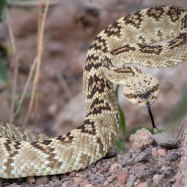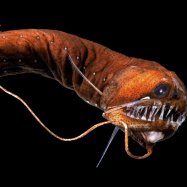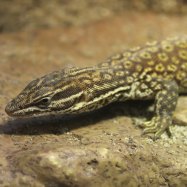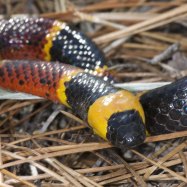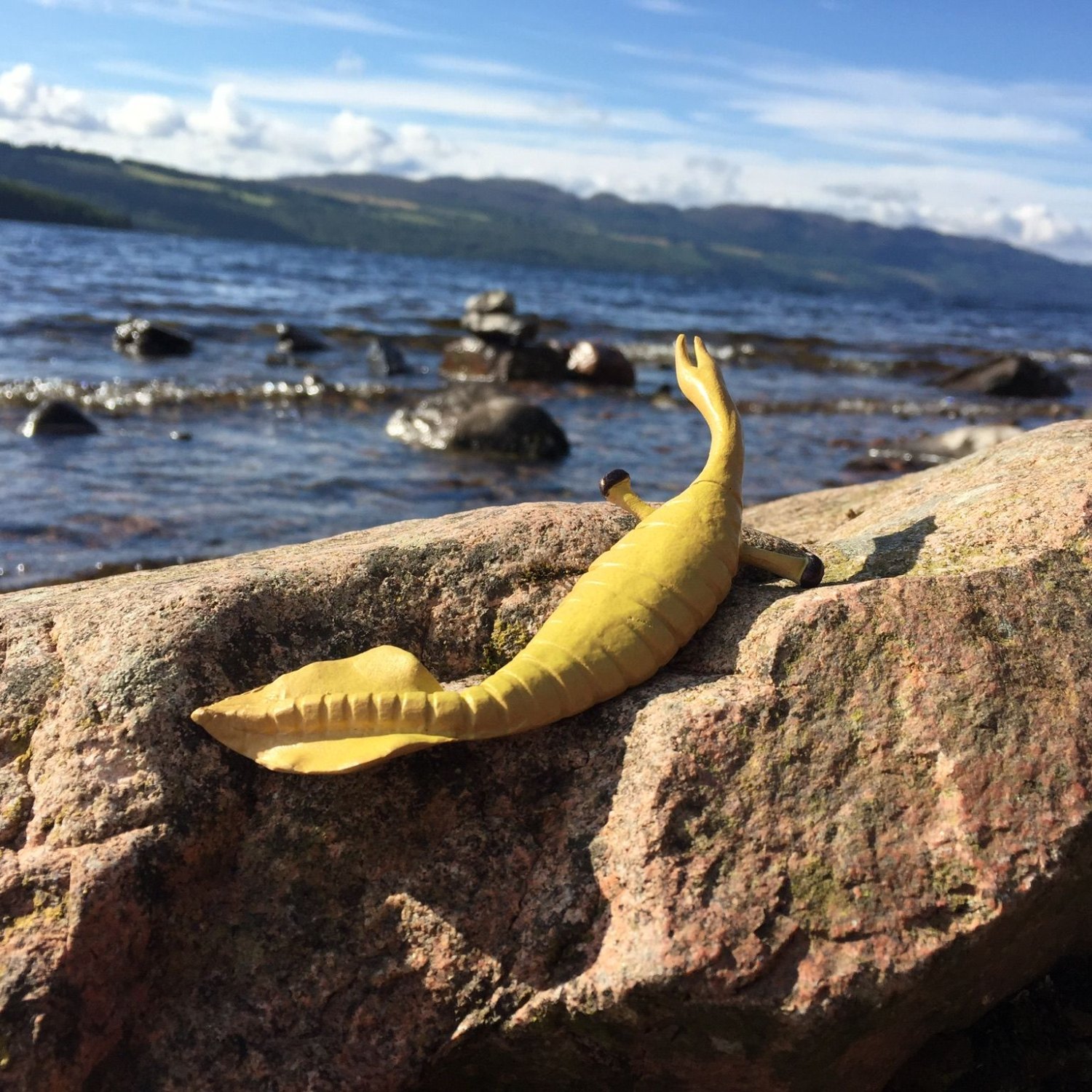
Tully Monster
Up to 35 centimeters
The Tully Monster is a mysterious and fascinating creature that roamed the oceans over 300 million years ago. With a body length of up to 35 cm and a soft, tubular shape, it is believed to be related to modern-day arthropods. Fossils of this enigmatic creature have only been found in Illinois, making it a unique part of the state's natural history. #TullyMonster #RareFossils #IllinoisNature
Animal Details Summary:
Common Name: Tully Monster
Kingdom: Animalia
Habitat: Freshwater
The Bizarre Mystery of the Tully Monster: Unraveling the Enigma of an Ancient Creature
Imagine a creature with a long, tubular body, a protruding mouth with sharp teeth, and eyes on stalks. Its appearance is so strange that it almost seems like a figment of someone's imagination. However, this creature, known as the Tully Monster, is not a product of fiction but a real animal that roamed the Earth more than 300 million years ago.The Tully Monster, scientifically known as Tullimonstrum gregarium, is one of the most mysterious creatures to ever exist Tully Monster. It was discovered in 1957 by Francis Tully, a fossil collector, in Mazon Creek in Illinois, United States. The Tully Monster has baffled scientists for decades, and even today, its origins and place in the animal kingdom remain a mystery. Let us delve into the intriguing world of the Tully Monster and uncover the secrets of this enigmatic creature.
A Creature Without a Home: Classification of the Tully Monster
One of the most intriguing aspects of the Tully Monster is its classification. While we know it is an animal, its exact place in the animal kingdom is still a subject of debate. According to the current classification system, the Tully Monster is classified as "incertae sedis," which means "of uncertain placement." This classification means that the Tully Monster does not fit into any known animal groups, making it a truly unique and mysterious creature.Anatomy and Characteristics of the Tully Monster
Despite its unique appearance, scientists have been able to study and analyze the anatomy of the Tully Monster through its well-preserved fossils. The Tully Monster had a soft, tubular body that could reach up to 35 centimeters in length Tiktaalik. It had fins on its sides, resembling a modern-day fish, and a long, protruding mouth with sharp teeth.One of the most distinguishing features of the Tully Monster is its eyes on stalks, which could rotate to give it a 360-degree view. The creature's eyes also had a complex structure, with layers of tissue that could control the amount of light entering, much like modern-day squids. This feature suggests that the Tully Monster was an intelligent creature capable of visual processing, making it more advanced than other animals during its time.
A Predator of the Deep: The Feeding Habits of the Tully Monster
The Tully Monster had a carnivorous feeding habit, and its body structure provided clues about its hunting style. The creature's long, tubular body and sharp teeth suggest that it was a fast swimmer capable of chasing and capturing its prey. Its eyes on stalks and complex visual system also indicate that the Tully Monster relied on its senses to locate and hunt its prey.There is still some debate about the exact diet of the Tully Monster. Some scientists believe that it was a bottom-dwelling creature, while others suggest that it was a swift swimmer that caught its prey in open waters. However, the most commonly accepted theory is that the Tully Monster fed on small fish, crustaceans, and other invertebrates, using its sharp teeth to pierce and kill its prey.
A Natural Habitat: The Freshwater World of the Tully Monster
The Tully Monster was a freshwater creature, and its fossils have only been found in the Mazon Creek fossil beds in Illinois, United States. This area was once a large inland sea during the Carboniferous period, providing the perfect habitat for the Tully Monster to thrive. The Mazon Creek fossil beds are famous for their well-preserved fossils, and it is where the Tully Monster was first discovered.Some scientists suggest that the Tully Monster may have migrated to other freshwater habitats during its time, but there is not enough evidence to support this theory. However, it is possible that the Tully Monster was a solitary creature that preferred to inhabit deep, quiet waters, making it challenging to find its fossils in other areas.
Uncovering the Enigma: The Search for the Tully Monster's Country of Origin
While the Tully Monster was discovered in Illinois, there is still some debate about its country of origin. Some scientists believe that it was a native creature to the area, while others suggest that its ancestors may have come from other parts of the world. However, there is not enough conclusive evidence to determine the Tully Monster's country of origin.One theory suggests that the Tully Monster may have come from Asia and migrated to Illinois when the area was part of the supercontinent Pangaea. Another theory suggests that it may have evolved in the Mazon Creek area itself, providing further evidence that it may have migrated to other parts of the world during its time. However, these are all just theories, and the exact origin of the Tully Monster remains a mystery.
Beyond the Fossils: Unknown Coloration of the Tully Monster
One of the biggest mysteries surrounding the Tully Monster is its coloration. While we know what it looked like, it is challenging to determine its exact color due to its well-preserved but flattened fossils. However, some theories suggest that the Tully Monster may have been light-colored with dark spots, much like modern-day sharks and rays.One of the reasons for this theory is that most animals with light-colored bodies live in dark environments, and the Tully Monster may have inhabited deep, dark waters. Additionally, this coloration could have been a form of camouflage, allowing the Tully Monster to blend in and evade predators.
A Scientific Puzzle: The Tully Monster's Place in Evolution
The Tully Monster has confounded scientists for decades, and its place in evolution is still a subject of debate. Some scientists believe that it was a primitive vertebrate, closely related to modern-day lampreys or hagfish. Others suggest that it may have been an entirely new type of animal that is no longer found on Earth.Another theory proposes that the Tully Monster may have been a transitional creature that evolved from early invertebrates to modern-day vertebrates. However, this theory is difficult to prove, as there is no evidence of creatures similar to the Tully Monster in the geological timeline.
In Conclusion
The Tully Monster is a true enigma of the animal world. Its strange appearance and classification as "incertae sedis" make it a unique and mysterious creature. Despite years of research and analysis, we are still far from solving the mystery of this ancient animal. However, this lack of certainty only adds to the fascination and intrigue surrounding the Tully Monster, making it a favorite subject of study for scientists and fossil enthusiasts alike. Perhaps one day, we will uncover the secrets of this bizarre creature, but until then, the Tully Monster will remain a fascinating and mysterious piece of the Earth's history.

Tully Monster
Animal Details Tully Monster - Scientific Name: Tullimonstrum gregarium
- Category: Animals T
- Scientific Name: Tullimonstrum gregarium
- Common Name: Tully Monster
- Kingdom: Animalia
- Phylum: Chordata
- Class: incertae sedis
- Order: incertae sedis
- Family: incertae sedis
- Habitat: Freshwater
- Feeding Method: Carnivorous
- Geographical Distribution: North America
- Country of Origin: United States
- Location: Fossils found in Illinois
- Animal Coloration: Unknown
- Body Shape: Soft-bodied with a long tubular shape
- Length: Up to 35 centimeters
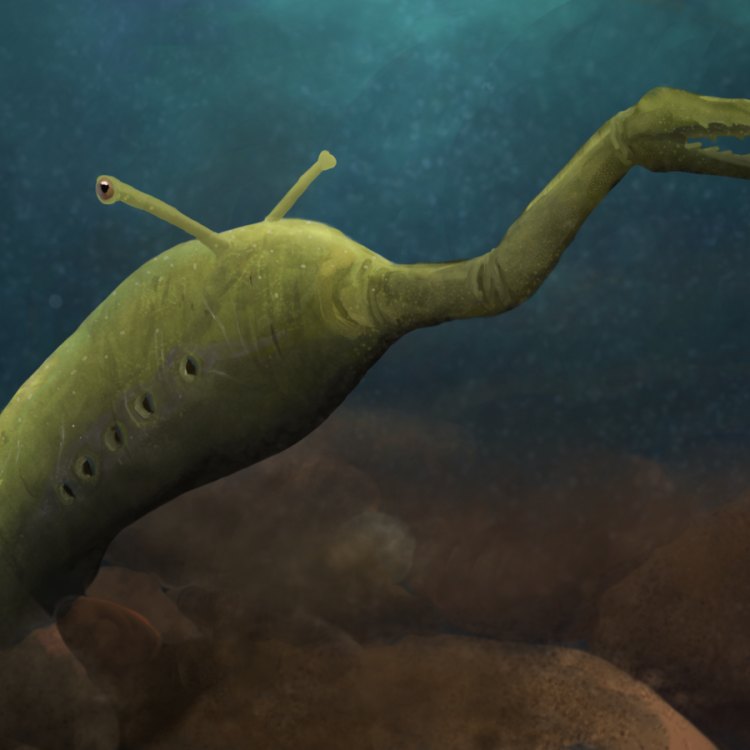
Tully Monster
- Adult Size: Not determined
- Average Lifespan: Not determined
- Reproduction: Unknown
- Reproductive Behavior: Unknown
- Sound or Call: None
- Migration Pattern: Unknown
- Social Groups: Unknown
- Behavior: Unknown
- Threats: Extinction (fossils only)
- Conservation Status: Extinct
- Impact on Ecosystem: Uncertain
- Human Use: Fossil collecting
- Distinctive Features: Long tubular body with a mouth at one end and a pair of prominent eyes at the other end
- Interesting Facts: The Tully Monster is an enigmatic extinct species that lived over 300 million years ago during the Carboniferous period. It was only known from fossilized impressions found in the Mazon Creek fossil beds in Illinois. Its exact classification and relationship to other animals remain uncertain.
- Predator: Unknown
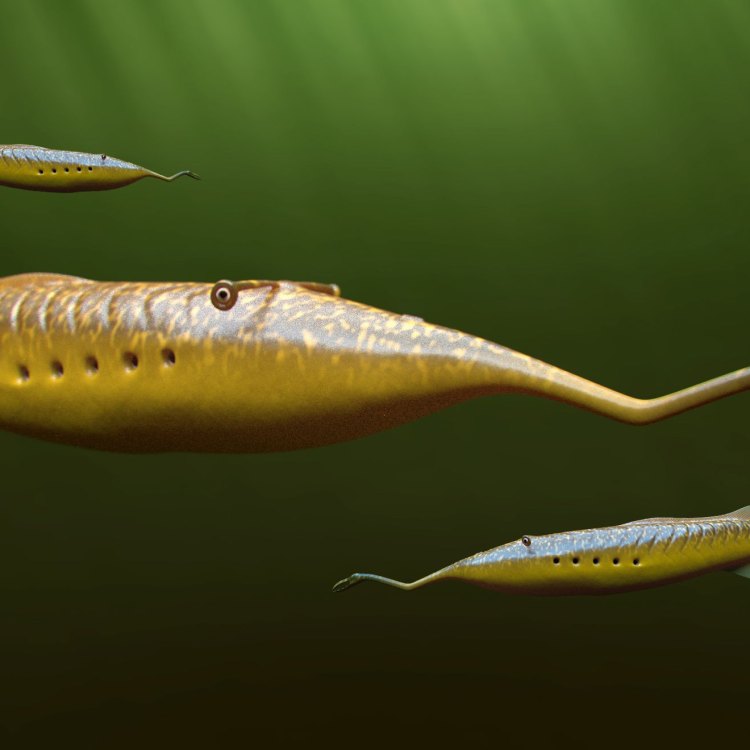
Tullimonstrum gregarium
The Mysterious Creature: Unraveling the Secrets of the Tully Monster
Deep in the fossil beds of Mazon Creek, Illinois, lies a creature unlike any other. Its long tubular body, with a mouth at one end and a pair of prominent eyes at the other, has baffled paleontologists for decades. This is the Tully Monster, an extinct species that lived over 300 million years ago during the Carboniferous period. Despite numerous studies and debates, its classification and relationship to other animals remain a mystery PeaceOfAnimals.Com. In this article, we will delve into the unique features and interesting facts of the Tully Monster, and discover why it continues to fascinate scientists and enthusiasts alike.The Elusive Characteristics of the Tully Monster
The Tully Monster, scientifically known as Tullimonstrum gregarium, was first discovered in 1958 by Francis Tully, a fossil collector and amateur geologist. He was digging through the coal mines of Mazon Creek when he stumbled upon a peculiar fossil that he couldn't identify. The fossil had a long, thin body with a strange-looking proboscis at one end and a pair of stalked eyes at the other. At first, Tully thought it was a worm, but as he continued to find more specimens, he realized that it was something altogether different.Since its discovery, the Tully Monster has been a baffling enigma for paleontologists. Its exact classification and relationship to other animals remain uncertain, as it does not fit into any known phylum. It is typically described as a soft-bodied marine invertebrate, but its true identity and behavior remain a mystery. Due to the limited number of specimens and their fragile nature, it has been challenging to extract any significant information from them Tapir. With no living or closely related species to study, scientists can only speculate about its life history.
The Fascinating Features of the Tully Monster
Despite its uncertain classification, the Tully Monster has some distinctive features that make it stand out. Its most notable feature is its long tubular body that could grow up to 30 centimeters in length. It was composed of a flexible, conical rod of material called the notochord, which is present in some primitive animals such as lampreys. The notochord provided structure and support to the Tully Monster's body.At one end of its body, the Tully Monster had a mouth with sharp teeth, suggesting that it was a carnivore. The unique proboscis at the other end remains a mystery. Some scientists believe it was used for sensing, while others argue that it may have been a snorkel-like structure for breathing. The Tully Monster also had a pair of stalked eyes that allowed it to see in different directions, giving it an advantage in detecting predators. Its eyes were large and complex, with over 18,000 lenses, suggesting that it had advanced vision for its time.
The Intriguing Life of the Tully Monster
One of the biggest mysteries surrounding the Tully Monster is its reproductive behavior. No fossilized eggs or embryos have been found, making it difficult to determine how it reproduced. Some scientists speculate that it may have laid eggs, while others propose that it gave birth to live young. However, without any concrete evidence, the Tully Monster's reproductive behavior remains unknown.Its average lifespan and adult size are also undetermined due to the limited availability of fossils. Scientists estimate that it may have lived for a few years and reached full maturity at a length of 20 centimeters. Its behavior and migration patterns are also a mystery, as there is no evidence to suggest if it was a solitary or social animal or if it moved around.
The Dangers that Threaten the Tully Monster
The Tully Monster existed during a time of great environmental change, with shifting coastlines, fluctuating sea levels, and changing climates. These factors may have contributed to its eventual extinction. However, the primary threat to the Tully Monster's survival was fossil collecting. Due to its unique appearance and rarity, it quickly became a sought-after fossil for collectors. As a result, many specimens have been lost or destroyed, making it even more challenging to study and understand this mysterious creature.The Uncertain Impact on the Ecosystem
The Tully Monster's role in the ecosystem remains uncertain due to the lack of information about its behavior and diet. Some scientists speculate that it may have been an active predator, preying on smaller creatures in the muddy seabed. Others propose that it may have been a scavenger or filter feeder, feeding on dead or decaying materials. As such, its extinction may have had a significant impact on the ecosystem, but its specific role is yet to be determined.The Human Fascination with the Tully Monster
The Tully Monster has captured the imagination of many, from paleontologists and scientists to casual fossil enthusiasts. Its strange and unique features, along with its elusive nature, have made it a subject of fascination and study for decades. Despite its mystifying characteristics, the Tully Monster has not been recognized as an official state fossil of Illinois, where it was discovered. However, the popularity of this creature has led to many references in popular culture, with appearances in books, comics, and even video games.Uncovering the Secrets of the Tully Monster
Despite numerous studies and debates, the Tully Monster continues to be a mystery to scientists. Its classification, behavior, and role in the ecosystem are yet to be fully understood. As more fossils are discovered and new technologies are developed, there is hope that we will one day unravel the secrets of this enigmatic creature.While the Tully Monster may be extinct, its legacy lives on through the fossils that continue to captivate our imagination. It serves as a reminder of the diversity of life that has existed on our planet and the importance of preserving and studying these ancient creatures. So the next time you stumble upon a Tully Monster fossil, remember that you are holding a piece of a puzzle that has yet to be solved.

The Bizarre Mystery of the Tully Monster: Unraveling the Enigma of an Ancient Creature
Disclaimer: The content provided is for informational purposes only. We cannot guarantee the accuracy of the information on this page 100%. All information provided here may change without prior notice.

